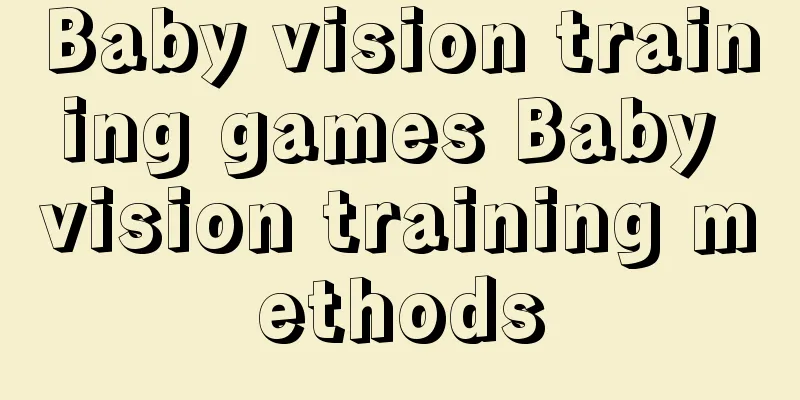Baby vision training games Baby vision training methods

|
In order to develop the baby's brain in time, many mothers start prenatal education from the fetal period. Today, I will share with you how to train the baby's visual ability and use the correct method to develop the baby's intelligence. Baby's normal visual response test methodExamination 1: The newborn's pupils react to light Hold a flashlight and cover one eye of the baby first, then shine the flashlight on the other eye. If the pupil shrinks immediately after being exposed to the light, it is a normal visual reaction. Test the other eye in the same way. If the pupil does not shrink with the light, it is abnormal. Examination method 2: 2-month-old baby has fixation reaction and blink reaction Put a bottle or toy in front of the baby. If the baby blinks the moment he sees the object in front of him, it is a normal visual reaction, that is, blink reaction; then the baby's eyes will stare at the object in front of him for a certain period of time, which is the so-called fixation reaction. When the baby is older, his eyes can also move with the movement of the object he is staring at. Examination method 3: Babies aged 3-4 months have visual movement nystagmus Place a cylinder with black and white stripes in front of the baby's eyes, and move and rotate the cylinder horizontally at the same time to observe whether the baby's eyeballs follow the cylinder's rotation. If the eyeballs rotate with the cylinder, it is a normal visual response. Regarding the question of how to check the baby's normal visual reaction, experts introduced the above three methods to us. These three methods are the most common methods to check whether the baby's vision impairment is normal. After checking with these three methods, if the baby is found to have vision impairment, we hope that parents can actively seek treatment for the baby. Vision training game1. Look at the mother's face - the mother often consciously lets the baby look at her face, bends over to talk to the baby, calls his name or smiles at him, and constantly changes the angle of gaze. "Eye to eye" can convey the mother's love for the child and enhance the mother-child relationship. 2. The mother can also use a flashlight covered with a red cloth to attract the baby's attention. The flashlight should be sometimes far away, sometimes near, sometimes left, sometimes right, and the mother should keep talking to the baby. If it is at night, you can use "turn on the light" and "turn off the light" alternately. Remember to change the position of the light and the baby's posture frequently. 3. Hang some bright and noisy toys on the crib to attract the child's attention. Toys and other items should be changed frequently to avoid causing strabismus. 4. Look into the distance - in front of the window or outdoors, guide your child to look at things as far away as possible. Eye development at different agesFetal period When the baby is in the mother's womb, it can sense light at around 5 months, and can distinguish between darkness and light at around 9 months. 7–8 weeks The structure of the fetus's eyes is roughly complete, but it is unclear whether they are functional. 8–12 weeks Nerve fibers connecting the eyes to the brain also begin to develop and form eyelids. 12-17 weeks The visual apparatus is fully developed. 17-20 weeks Although the eyelids are still closed, the retina can already sense the light. If you shine a flashlight on the fetus, he will frown because of the glare. 25-28 weeks The fetus can open its eyes and look forward, and has the ability to slightly adjust the focus, but the pupil color will not return to normal color until several months after birth. 32-36 weeks The fetus's reaction to light will be further developed, with large movements such as turning the head, reaching out to touch, etc., and small movements such as moving the eyeballs, focusing, etc. The fetus can also distinguish between darkness and light by closing its eyes. After birth Many people used to think that the visual development of a baby would not be fully mature until the age of 4 to 5. But now the medical community generally believes that all imaging development is complete when the baby is about 1 year old. 0-4 months Babies are born with contrast (black and white) vision. When they are 2 to 3 months old, they will look at things at a fixed point and even turn their heads to chase moving objects. At around 4 months old, they will start to follow moving objects by moving their eyes. Toys for babies at this stage should be of contrasting colors (such as black and white). 4–6 months At this time, the baby already has a sense of three-dimensionality and binocular vision has matured, so the eyes and hands can coordinate with each other to perform simple movements. You can try to let your baby hold the bottle (the parent needs to hold the bottle because he cannot bear the weight of the bottle yet) or teach him to clap his hands, or even give him a clean, chewable toy to see if he will reach out to take the toy and put it in his mouth. 6-8 months When the baby develops from lying down to sitting up, it also means that the baby's vision range develops from left and right to up and down. For the baby, his field of vision is completely different. In addition to colors, toys that provide stimulation at this time can also have sounds, because the baby's eyes, hands, feet, body and other coordination abilities are better at this stage, so it is the best period for the integration of vision, hearing and facial expressions. 8–12 months At this time, babies usually like to sit and throw things, then crawl to chase objects, or want to stand to get things, etc. That's because the baby sees objects and measures the distance by throwing things, and also has a sense of space, which also proves the baby's visual development. Many behaviorists believe that when babies are 10 to 12 months old, they should be allowed to crawl more and not be rushed to induce them to stand up and walk, because establishing a good sense of space during the crawling stage will help them walk more steadily in the future. After 1 year old You can give some more delicate toys or objects for stimulation, because the baby's imaging development is mature at this time. Around 3 years old You can take it to an ophthalmologist for a vision test. 1. Many parents will play with their babies with toys, hoping to give their babies all kinds of Stimulation. For babies under 1 year old, the eye focusing function is not yet complete, and the cone cells that control movement are not mature, so when giving toys or objects to babies, do not move them too fast. 2. Many babies tend to have corns before they are 4 months old. When a baby is just born, its facial features are not yet fully formed and the distance between its eyes is relatively wide. Secondly, the muscles near the baby's eyes are not yet well coordinated, so it is easy for the baby to have corns when looking at things. If this is still the case after the baby is over 5 months old, medical attention is needed. About Vision In a 1990 article titled "What Can My Baby See" by Dr. Russell D. Hamer, it was stated: A one-month-old baby has an initial force of about 20 cm, which is 1/6 of a normal person. A 4-month-old baby's vision is about 40 cm, which is 1/3 of a normal person's. An 8-month-old baby has a visual acuity of about 80 cm, which is 2/3 of a normal person's. That is to say, if the normal reading distance is about 35 cm, then the one-month-old baby needs to be closer to about 6 cm; the four-month-old baby is about 12 cm; the eight-month-old baby is about 24 cm. Therefore, the first eight months is the period of high visual development. |
<<: Can I eat okra while breastfeeding? Is it good to eat okra while breastfeeding?
Recommend
Is the American Arm&Hammer baking soda toothpaste good to use?
Toothpaste is a common cleaning product that we u...
Can 75% alcohol wipes be used to wipe baby's hands? Can 75% alcohol wipes be used to wipe tableware?
The most common alcohol wipes are 75% alcohol wip...
How to distinguish lochia from menstruation by judging the color and time
After the baby is born, the mother's uterus a...
Does Hirudoid scar removal cream contain hormones? Does Hirudoid scar removal cream contain hormones?
Does Hirudoid scar cream contain hormones? The mo...
When is the best time to take the ovulation injection? When is the best time to take the ovulation injection?
Many women who are eager to have children will ch...
Can pregnant women eat yam porridge? What should pregnant women pay attention to when eating yam porridge?
Everyone should have heard of a lot of food in li...
How to make tassel pendants? Make your home more artistic with tassel pendants
The fresh literary style is pursued by more and m...
When should we consider inducing labor? What kind of environment is best for confinement?
There are many things to consider after pregnancy...
Why do babies not sleep at night? How to care for babies?
New parents deeply understand how difficult it is...
How is the massage performed? What are the conditions of the baby's underwear?
Proper touch is crucial to the baby's physica...
Can roasted oranges cure children's coughs? Some points to note when roasting oranges to cure coughs
Injections and taking medicines are nightmares fo...
What foods can’t be eaten during breastfeeding? What should I do if my baby can’t finish the milk?
Everyone should know that it is better for childr...
What to do if there are lumps in the breast? It is necessary to express milk
It is easy for lumps to appear in the breasts whe...
How to eliminate the fear of childbirth in pregnant women
People will feel fear when facing unknown things,...
What is the AMH test? Rapidly test whether the ovaries are suitable for pregnancy
Fertility is a woman's innate ability and rig...









